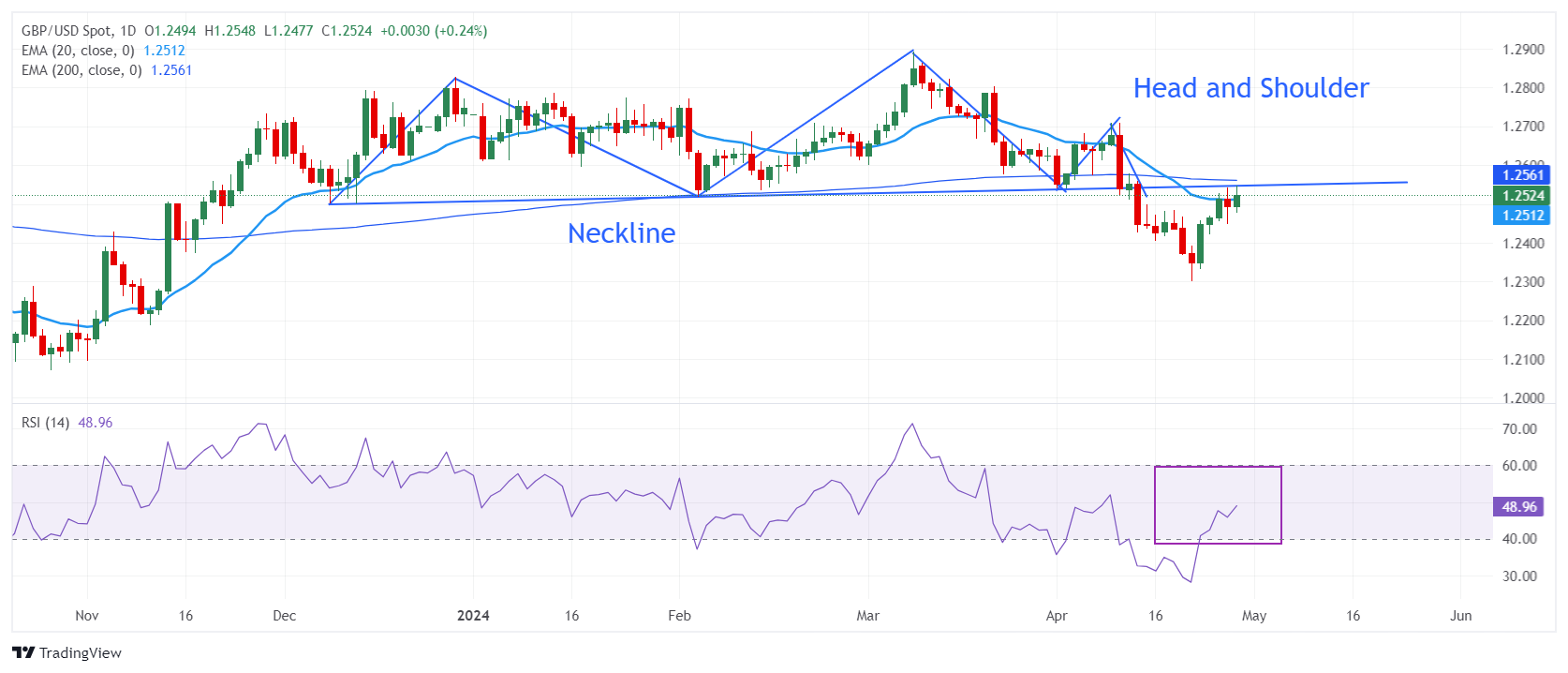- The Pound Sterling rises to a two-week high near 1.2550 amid an improved market mood.
- Investors see the BoE pivoting to interest rate cuts in the June or August meeting.
- The Fed’s policy decision on Wednesday and the NFP report on Friday will be the key events this week.
The Pound Sterling (GBP) hits a fresh two-week high against the US Dollar (USD) near 1.2550 in Monday’s early American session. The GBP/USD pair advances due to cheerful market sentiment and a decline in the US Dollar. The Cable strengthens as mixed guidance from Bank of England (BoE) policymakers over the inflation outlook increases uncertainty about when the BoE will start its interest rate cuts cycle.
BoE Deputy Governor Dave Ramsden said in mid-April that the risks of inflation remaining elevated have receded. Ramsden predicted headline inflation would return to the 2% target in May and said it would likely remain at this level for the next two years.
On the contrary, a few other BoE policymakers, such as Chief Economist Huw Pill, Jonathan Haskel, and Catherine Mann, aren’t that optimistic about the inflation outlook. Most of them have referred to the core Consumer Price Index (CPI) as the preferred measure for decision-making on interest rates, which is still high due to stubborn service inflation. Last week, Pill said: “Time for cutting bank rate remains some way off.”
Financial markets are expecting that the BoE will pivot to rate cuts in the June or August meeting. "It is between June and August, and we are leaning slightly towards August on the basis that one of the key things the BoE is looking at is service inflation," said James Smith, an economist at ING Financial Markets. "If services inflation is a little bit stickier, I think that tilts the balance a little bit further towards August over June, but it's a pretty close call, to be honest", he added.
Daily digest market movers: Pound Sterling exhibits strength ahead of US data-packed week
- The Pound Sterling rallies to 1.2550, capitalizing on improved market sentiment. S&P 500 futures have posted significant gains during the Asian session, suggesting an improvement in investors’ risk appetite. A slight decline in the US Dollar ahead of the Federal Reserve’s interest rate decision has also boosted the GBP/USD pair. However, firm expectations that the Fed will maintain the hawkish tone could support the US Dollar.
- The Fed is widely anticipated to hold interest rates steady in the range of 5.25%- 5.50% in its monetary policy meeting on Wednesday. Fed policymakers are expected to remain data-dependent for further decisions. The central bank will likely reiterate the need to gain more confidence before pivoting to rate cuts.
- A recent batch of consumer inflation data has not offered any relief to Fed policymakers. The United States core Personal Consumption Expenditure Price Index (PCE) data for March, released on Friday, indicated that higher service prices kept price pressures hotter than expected.
- Annually, the core PCE inflation data rose by 2.8%, higher than expectations of 2.6% and at the same pace as in February. The monthly inflation data grew parallel with the consensus and the prior release of 0.3%. The 0.3% growth in monthly core PCE is higher than needed for inflation to return to the desired rate of 2%.
- Apart from the Fed’s monetary policy decision, investors will also focus on the Institute for Supply Management (ISM) Manufacturing Purchasing Managers Index (PMI) data for April, which will be published on Wednesday. The ISM Manufacturing PMI is estimated to remain above the 50.0 threshold, which separates expansion from contraction. The factory data is seen at 50.1, lower than the prior reading of 50.3. The PMI survey by S&P Global for the same period showed a sharp decline in the scale of production and new orders due to inflationary pressures, weak demand and sufficient stock holdings at customers.
- Later this week, the US Nonfarm Payrolls (NFP) data will be the crucial event that will indicate the current status of the labor market.
Technical Analysis: Pound Sterling jumps above 1.2500
The Pound Sterling recovers losses registered in the last weeks and hovers near the neckline of the Head and Shoulder chart pattern. The neckline of the above-mentioned pattern is plotted from December 8 low around 1.2500.
The GBP/USD pair attempts to sustain above the 20-day Exponential Moving Average (EMA), at around 1.2510. The 200-day EMA, at 1.2550, is acting as a major barrier for the Pound Sterling bulls.
The 14-period Relative Strength Index (RSI) shifts into the 40.00-60.00 range, suggesting a consolidation ahead.
Risk sentiment FAQs
In the world of financial jargon the two widely used terms “risk-on” and “risk off'' refer to the level of risk that investors are willing to stomach during the period referenced. In a “risk-on” market, investors are optimistic about the future and more willing to buy risky assets. In a “risk-off” market investors start to ‘play it safe’ because they are worried about the future, and therefore buy less risky assets that are more certain of bringing a return, even if it is relatively modest.
Typically, during periods of “risk-on”, stock markets will rise, most commodities – except Gold – will also gain in value, since they benefit from a positive growth outlook. The currencies of nations that are heavy commodity exporters strengthen because of increased demand, and Cryptocurrencies rise. In a “risk-off” market, Bonds go up – especially major government Bonds – Gold shines, and safe-haven currencies such as the Japanese Yen, Swiss Franc and US Dollar all benefit.
The Australian Dollar (AUD), the Canadian Dollar (CAD), the New Zealand Dollar (NZD) and minor FX like the Ruble (RUB) and the South African Rand (ZAR), all tend to rise in markets that are “risk-on”. This is because the economies of these currencies are heavily reliant on commodity exports for growth, and commodities tend to rise in price during risk-on periods. This is because investors foresee greater demand for raw materials in the future due to heightened economic activity.
The major currencies that tend to rise during periods of “risk-off” are the US Dollar (USD), the Japanese Yen (JPY) and the Swiss Franc (CHF). The US Dollar, because it is the world’s reserve currency, and because in times of crisis investors buy US government debt, which is seen as safe because the largest economy in the world is unlikely to default. The Yen, from increased demand for Japanese government bonds, because a high proportion are held by domestic investors who are unlikely to dump them – even in a crisis. The Swiss Franc, because strict Swiss banking laws offer investors enhanced capital protection.
Information on these pages contains forward-looking statements that involve risks and uncertainties. Markets and instruments profiled on this page are for informational purposes only and should not in any way come across as a recommendation to buy or sell in these assets. You should do your own thorough research before making any investment decisions. FXStreet does not in any way guarantee that this information is free from mistakes, errors, or material misstatements. It also does not guarantee that this information is of a timely nature. Investing in Open Markets involves a great deal of risk, including the loss of all or a portion of your investment, as well as emotional distress. All risks, losses and costs associated with investing, including total loss of principal, are your responsibility. The views and opinions expressed in this article are those of the authors and do not necessarily reflect the official policy or position of FXStreet nor its advertisers. The author will not be held responsible for information that is found at the end of links posted on this page.
If not otherwise explicitly mentioned in the body of the article, at the time of writing, the author has no position in any stock mentioned in this article and no business relationship with any company mentioned. The author has not received compensation for writing this article, other than from FXStreet.
FXStreet and the author do not provide personalized recommendations. The author makes no representations as to the accuracy, completeness, or suitability of this information. FXStreet and the author will not be liable for any errors, omissions or any losses, injuries or damages arising from this information and its display or use. Errors and omissions excepted.
The author and FXStreet are not registered investment advisors and nothing in this article is intended to be investment advice.
Recommended content
Editors’ Picks

EUR/USD rises toward 1.1350 after finding support at near nine-day EMA
EUR/USD pauses its two-day decline, hovering near 1.1340 during Thursday’s Asian session. Daily chart technical analysis indicates a weakening bullish bias, as the pair has slipped below the ascending channel pattern.

GBP/USD: Bullish outlook remains in play above 1.3250
The GBP/USD pair drifts higher to around 1.3270, snapping the two-day losing streak during the early European trading hours on Thursday. Mitigating concerns over potential tariff threats by US President Donald Trump exerts some selling pressure on the US Dollar.

Gold price trims part of intraday gains, still well bid above $3,300 mark
Gold price regains positive traction as fading US-China trade optimism revives safe-haven demand. The US economic worries and Fed rate cut bets undermine the USD, also benefiting the commodity. A positive risk tone might hold back the XAU/USD bulls from placing aggressive bets and cap gains.

SEC Crypto Task Force plans to establish digital asset regulatory sandbox
The Securities & Exchange Commission's Crypto Task Force met with El Salvador's National Commission on Digital Assets representatives to discuss cross-border regulation and a proposed cross-border sandbox project.

Five fundamentals for the week: Traders confront the trade war, important surveys, key Fed speech Premium
Will the US strike a trade deal with Japan? That would be positive progress. However, recent developments are not that positive, and there's only one certainty: headlines will dominate markets. Fresh US economic data is also of interest.

The Best brokers to trade EUR/USD
SPONSORED Discover the top brokers for trading EUR/USD in 2025. Our list features brokers with competitive spreads, fast execution, and powerful platforms. Whether you're a beginner or an expert, find the right partner to navigate the dynamic Forex market.




